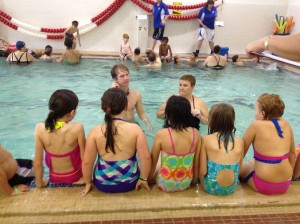Submitted Dr. Benjamin D. Ruder, DDS for Small To Tall Pediatric Dentistry
 As the sunny days make their return to the Pacific Northwest, kids of all ages figuratively and literally dive headfirst into their favorite outdoor activities: baseball, bike riding, swimming, swinging, and everything else under the sun. Unfortunately, with this increase in outdoor exuberance comes a rise in dental trauma and injury to the oral soft tissues. No one ever intends to fall and break a tooth or split a lip; but when it happens, timely and appropriate attention is key to minimizing adverse effects and maximizing a successful outcome.
As the sunny days make their return to the Pacific Northwest, kids of all ages figuratively and literally dive headfirst into their favorite outdoor activities: baseball, bike riding, swimming, swinging, and everything else under the sun. Unfortunately, with this increase in outdoor exuberance comes a rise in dental trauma and injury to the oral soft tissues. No one ever intends to fall and break a tooth or split a lip; but when it happens, timely and appropriate attention is key to minimizing adverse effects and maximizing a successful outcome.
Dental trauma is one of the most common results of head and neck injuries. Approximately 30% of all preschool children suffer from a dental injury to the primary dentition (baby teeth), while approximately 20% of adolescents and young adults sustain dental injury to the permanent teeth. The early stages of developing motor coordination (climbing, walking) are the primary reason for falls and consequent dental injury in preschool-aged children, while damage to the permanent teeth in adolescents and young adults is primarily related to falls, traffic accidents, violence, and sports.
Given this frequent nature of dental trauma in the early years of life, pediatric dentists receive extensive specialized training in the treatment and management of oral injuries. Determining proper treatment means not just looking at the type of trauma, but also the age of the child, status of tooth development, and extent of tooth, pulp or gum involvement. Along those lines, treatment for children with injury to primary teeth differs significantly from that of those with trauma to permanent teeth.
 Oral injuries can vary considerably in severity and level of involvement, and the severity is not always immediately evident. Parents and patients should realize that the oral environment is a very vascular region. Minor lip, tongue, cheek, or gingival lacerations can produce considerable bleeding; once controlled and managed, a more accurate assessment of the trauma can be made. Fortunately the oral soft tissues heal very quickly and successfully, and while the initial injury may appear alarming at first, the end-result is oftentimes unnoticeable. However, should an oral injury cause a deep laceration or uncontrollable bleeding, a consultation should be sought for appropriate management and attention.
Oral injuries can vary considerably in severity and level of involvement, and the severity is not always immediately evident. Parents and patients should realize that the oral environment is a very vascular region. Minor lip, tongue, cheek, or gingival lacerations can produce considerable bleeding; once controlled and managed, a more accurate assessment of the trauma can be made. Fortunately the oral soft tissues heal very quickly and successfully, and while the initial injury may appear alarming at first, the end-result is oftentimes unnoticeable. However, should an oral injury cause a deep laceration or uncontrollable bleeding, a consultation should be sought for appropriate management and attention.
In any one incident, teeth can be bumped, fractured, displaced, knocked out (avulsed), or a combination of the aforementioned. Each type of injury is managed differently, and timely follow-up with a dental professional is usually recommended in order to determine severity and specific treatment. The injuries that require the most immediate attention are those in which:
- A tooth fracture exposes the nerve.
- The tooth is noticeably displaced.
- A tooth is avulsed (knocked out).
Should you suspect the injury falls into any of these three scenarios, do not hesitate to contact your dental provider immediately. Most studies suggest that treatment provided within 60 minutes from the time of injury results in the most successful outcome. Delay in urgent treatment could potentially lead to the need for root canal therapy, or in worst case scenario could result in the unsuccessful rehabilitation of the tooth and eventual removal.
 The Academy of Dental Traumatology recently developed a useful online guide to aid both patients and providers to manage each specific type of dental trauma. While this guide is particularly informative, it should not be considered an alternative to a comprehensive exam provided by a dental professional. And certainly, if a head injury resulting in unconsciousness is ever witnessed or suspected, consultation with a medical physician is always recommended prior to addressing any dental issues.
The Academy of Dental Traumatology recently developed a useful online guide to aid both patients and providers to manage each specific type of dental trauma. While this guide is particularly informative, it should not be considered an alternative to a comprehensive exam provided by a dental professional. And certainly, if a head injury resulting in unconsciousness is ever witnessed or suspected, consultation with a medical physician is always recommended prior to addressing any dental issues.
Accidents and dental trauma are never planned, but can oftentimes be prevented in the case of sporting activities with the use of athletic mouthguards. Studies have shown that the risk for dental injury nearly doubles when a protective mouthguard is not worn during certain sporting activities. Store-bought athletic mouthguards provide adequate protection, and are most useful for the growing child in which the dental status is actively changing. But for more ideal protection of permanent teeth in young adults, improved comfort, and unique color design, custom-fit mouthguards can be easily fabricated by your dental provider.
As much as we wish we could protect our children from accidents and injury, they are oftentimes a fact of life despite all best intentions. When dental trauma does occur, the way in which the situation is managed can make all the difference. Sometimes the treatment is simple, and sometimes a more complex approach is required. No matter the case, quick diagnosis and treatment is always best. For any questions regarding dental trauma or your child’s dental health, please feel free to contact Small to Tall Pediatric Dentistry.
References:
- Andersson, Lars. Epidemiology of traumatic dental injuries. Pediatric Dentistry. 2013; 35(2): 102-5.
- American Academy of Pediatric Dentistry. Guideline on Management of Acute Dental Trauma. AAPD Reference Manual. 2012-2013; 34(6): 230-238.
- http://www.dentaltraumaguide.org



















































